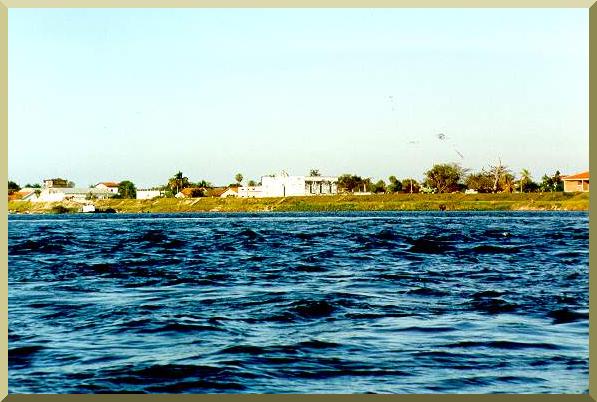
| The Paraguay river at Porto Murtinho, Mato Grosso do Sul, Brazil. |
INTRODUCTION

| The Paraguay river at Porto Murtinho, Mato Grosso do Sul, Brazil. |
|
The Pantanal of Mato Grosso is a seasonally inundated depression wholly contained within the Upper Paraguay river basin. It encompasses 136 700 km2 in the states of Mato Grosso and Mato Grosso do Sul, in Central Western Brazil. The Pantanal is an immense and biologically diverse wetland, geomorphologically and hydrologically positioned to attenuate and reduce the runoff from the Upper Paraguay river basin (Figs. 1 and 2 of Appendix 2). The proposed Paraná-Paraguay Waterway Project, commonly known as the Hidrovia Project, entails navigational improvements along the existing Paraná-Paraguay waterway, which links five countries in South America: Argentina, Bolivia, Brazil, Paraguay, and Uruguay. Engineering and environmental impact studies are currently (1996-97) being funded by the Inter-American Development Bank (IDB) and the United Nations Development Programme (UNDP). Funding for the construction of the project may be considered at a later date. An economic feasibility study completed by the Brazilian company Internave serves as a reference for the ongoing studies (INTERNAVE, 1990). The Internave study considers extensive river engineering works--including channel straightening, dredging, and blasting of rock outcrops--to render 3442 km of the river navigable for ocean-going vessels from Nueva Palmira, Uruguay, to Cáceres, Mato Grosso, Brazil. Since the port of Cáceres is located upstream of the Pantanal, it is expected that the project will have an impact on the Pantanal. The physical aspects of the proposed Hidrovia are the source of significant concern among indigenous peoples, environmental organizations, nongovernmental organizations (NGOs), professional associations, and universities and research institutions in Mato Grosso, Mato Grosso do Sul, Brazil, the American continent, and the rest of the world. At issue is the impact that extensive channel modifications, which would include channel straightening and deepening, will have on the Pantanal, the largest remaining wetland in the world (Alho et al, 1988). The uniqueness of the Pantanal ecosystems is widely recognized, and the need for their preservation on both intrinsic and economic grounds has been amply discussed in scientific, governmental, and political forums (EMBRAPA, 1986; Brazilian Constitution, 1988). The Pantanal of Mato Grosso is characteristically a wetland. Therefore, a study of the impact of the proposed project should start with the hydrologic cycle, from which all the other cycles of nature (uplift/denudation, sediment, nutrient, and biogeochemical cycles) derive. Thus, this study focuses on the hydrologic impacts of the proposed Hidrovia project on the Pantanal of Mato Grosso. Other environmental impacts, directly or indirectly related to the hydrologic impacts, are also considered. The complexity of the Pantanal ecosystems does not permit a definitive study, particularly since their myriad of abiotic/biotic interrelations are only now being thoroughly examined. Moreover, the main features of the project (the location, nature and extent of human interventions in the river) are still in the process of being defined. Thus, this report is subtitled: A Reference Study. As such, it should serve as a reference for professionals in government, funding agencies, consulting firms, nongovernmental organizations, and universities, and others interested in reconciling human needs with the workings of nature in the context of the Pantanal. |